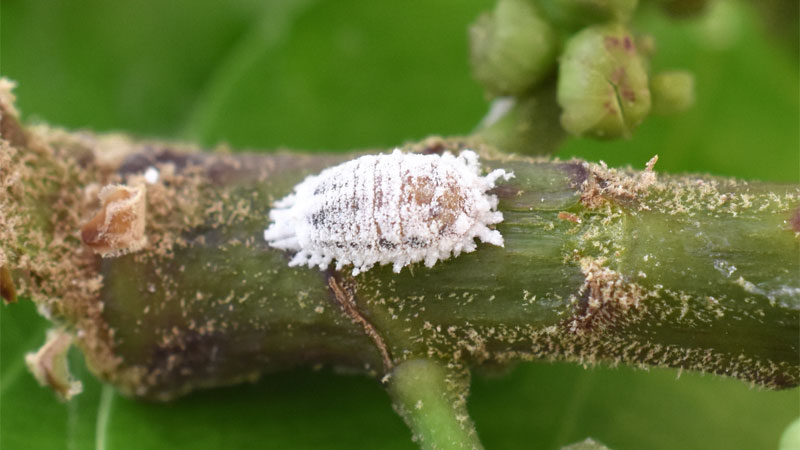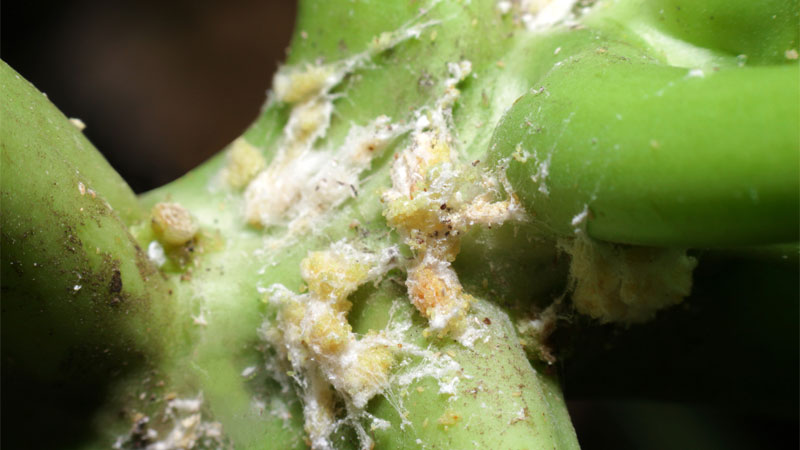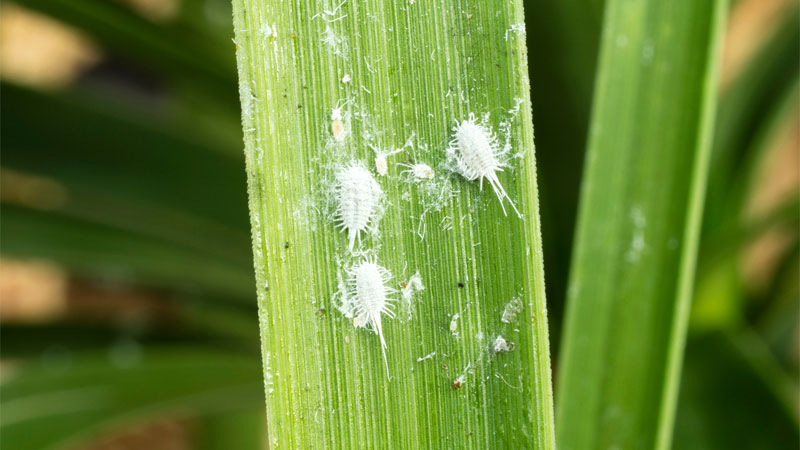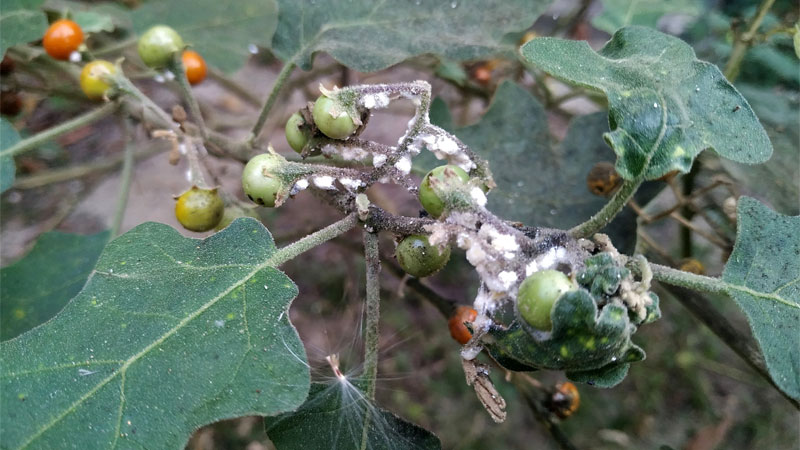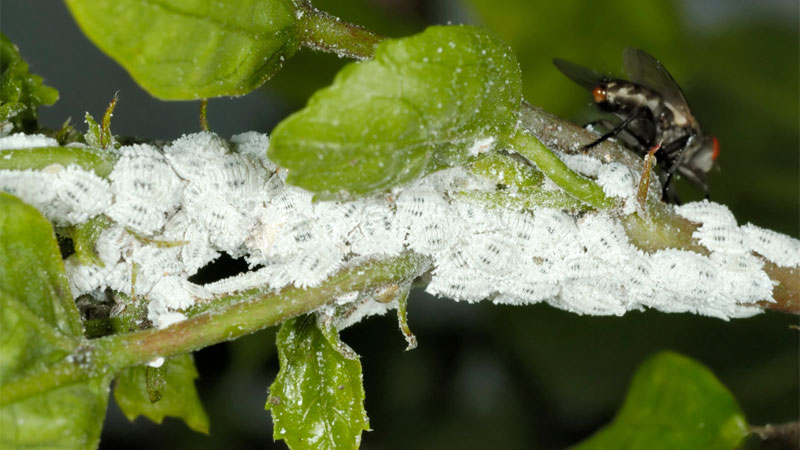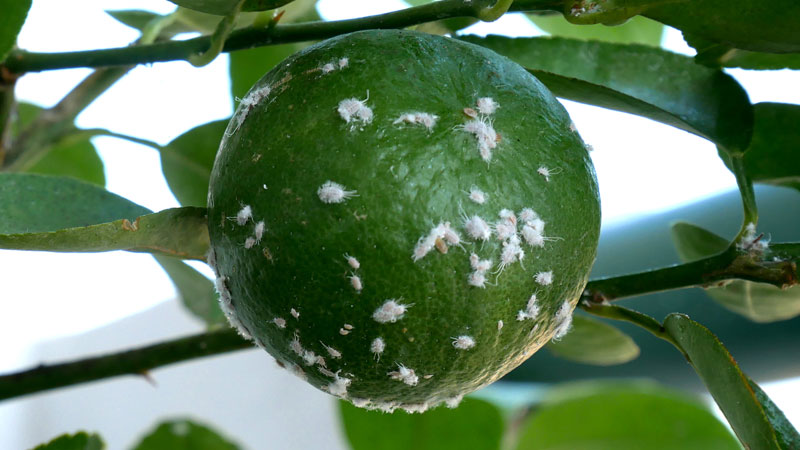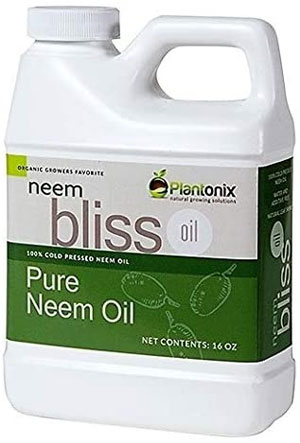It can happen to anyone. You’re tending to your garden or a prized indoor plant and notice a bit of cottony fuzz on one of the leaves. When you go to brush it off, the bit of cotton suddenly moves on its own. And then it hits you – you’ve got mealybugs.
These critters are a major bane for everything from ornamental house plants to outdoor food crops and even some species of tree.
It can take a while to get control of these tiny terrors once they’ve infested a plant, but it’s far from impossible and often preventable. Here’s how to get rid of mealybugs and keep them from spreading.
Getting to Know Mealybugs
Mealybugs are a type of scale, and there are approximately 270 known species in the US alone. They usually range from white to grey, but some species are red, pink, orange, or other colors.
They have 1/5 to 1/3 inch, multi-segmented bodies resembling tiny pill bugs. However, the mealybug is best known for its protective waxy coating. When paired with the filaments present on most species, an adult mealybug looks like a small cottony mass and is easily overlooked.
Unlike most other scale, mealybugs remain mobile and wears their wax coating like a suit of armor. Slow moving, they tend to hide in hard-to-see places such as the undersides of leaves and tiny crevasses or joints along the plant’s stem and limbs.
See Also: How to Get Rid of Thrips
Mealybug Life Cycle
While there’s some variation between species, mealies tend to follow a general life cycle pattern. Eggs hatch in one to three week, with the female nymphs having three instar stages and males having five.
The female nymphs usually locate a good feeding ground soon after hatching. They begin producing their waxy coating once feeding has begun. Males only feed for the first two instars and spend the rest of their lives fertilizing the females.
Under the right conditions, a female mealybug will go through all three instars into adulthood in as little as one month. She then lays clutches containing a grand total of 300 to 600 eggs over a two-week period, dying soon afterwards.
What Do Mealybugs Eat?
Mealies have piercing mouthparts which allow them to break through the skin of a plant and drink its sap. As with other scale critters, the initial pressure from puncturing the plant is so great that plant sap is forced straight through the mealybug’s body and excreted as honeydew.
Mealybugs tend to prefer the underside of leaves, but will also attack the main body of a plant or its roots.
Some mealybugs which target trees will crawl under the bark where they can safely feed away from the eyes of predators. In some heavy infestations, mealies have been known to attack the fruit of plants, although this isn’t the norm for most species.
Impact of Mealybugs
Mealybug infestations can explode when not treated quickly. These critters will damage and even destroy plants, draining them dry like vampires. A large enough infestation can make even the strongest host plant unsalvageable given the chance.
Even in minor infestations, the feeding can slow plant growth and results in yellow leaves and leaf drop. Ground mealybugs will attack a plant’s roots, often going unnoticed until it’s too late.
Even worse is the ability of mealybugs to cause secondary infections. Their honeydew is a primary draw for sooty mold and attracts ants. The victim plant’s immune system is compromised, leaving it open to a wide range of bacterial and fungal infections.
Common Species of Mealybug
Among the hundreds of mealybug species out there, a handful tend to stick out, either because of the plants they prefer or distinctive features. Here are a few to keep an eye out for:
Citrus Mealybug (Planococcus citri) – Perhaps the most common species of mealybug in homes, the citrus mealybug also attacks various shrubs and citrus species. It has a dark stripe along its back which may or may not be visible.
Cypress Bark Mealybug (Ehrhornia cupressi) – Found primarily on cedar, cypress, and juniper; this species is red to bright orange, allowing it to blend in when hiding beneath bark plates.
Grape Mealybug (Pseudococcus maritimus) – Easily mistaken for the obscure mealybug, this species targets fruit trees and grape vines. When prodded, it will excrete a reddish orange fluid in defense.
Ground Mealybug (Rhizoecus spp.) – One of the more unusual species, this subterranean variety lacks filaments and is especially attracted to African violets and potted plants.
Longtailed Mealybug (Pseudococcus longispinus) – A common attacker of grapes, citrus, and indoor ornamentals, the longtailed mealybug gets its name from two tail filaments that make up more than half its full length.
Obscure Mealybug (Pseudococcus affinis) – This species attacks a wide range of mostly outdoor plants and can be identified by its unique filaments and powdery coating.
Pink Hibiscus Mealybug (Maconellicoccus hirsutus) – This aggressive species has a pink body and attacks a wide range of crops, including fruits, vegetables, coffee, and sugarcane. It first spread to Florida from the Caribbean in 2002 and is also known to be prevalent in parts of California. Its saliva is toxic to the plants it feeds on.
Vine Mealybug (Planococcus ficus) – A species that attacks several types of ornamental tree, the vine mealybug has short filaments and a distinctive stripe down its back. It can attack both the roots and body of a plant, and is especially problematic for vineyards.
The Difference between Aphids, Mealybugs, and Scale
While generally described as different pests, aphids, mealybugs, and scale are all closely related. Hailing from the order Homoptera and suborder Sternorrhyncha, Aphids are mostly pear-shaped insects that belong to the superfamily Aphididae, while scale and mealybugs are oval and come from the superfamily Coccoidea.
All three pest groups have piercing mouthparts, drink sap, and produce honeydew.
The Coccoidea superfamily has three major families within it. Coccidae itself are the soft-bodied scales. Diaspididae are the armored scales. The third family, Pseudococcidae, are the mealybugs. Another family in Coccoidea, Putoidae, contains approximately 60 species of a type of scale known as “giant mealybugs”.
In reality, dealing with scale and mealybugs is almost identical, so there’s little need to distinguish the two under most circumstances.
Prevent the Spread
Regardless of whether the victim plant is indoor or outdoor, the first thing you should always do is isolate it, if possible. Mealybugs get around, and an infestation can soon spread to neighboring plants.
If the plant is mobile, move it to an isolated room and sterilize the area it was living in. You may wish to also quarantine nearby plants until you can check them for the presence of mealybugs.
For stationary plants, such as trees, large shrubs, or food crops, this might not be possible. The good news is that you have a few ways to deal with these problems that aren’t possible with indoor plants. You might also consider sacrificing an infested plant in your garden before the mealybugs can spread.
Safe Disposal
Whether sacrificing the entire plant or pruning away infested parts, you should always follow some strict surgical methods.
- Sterilize all of your tools in alcohol, preferably dipping after each cut.
- Wear protective gloves in case a particularly bright mealy decides to escape onto your hand.
- Never let an infected plant or clipping fall. Instead, carefully hold it when cutting and immediately transfer it to a sealable plastic bag.
- Under no circumstances should you allow the infected plant to touch a neighbor during the procedure, as it might allow a few mealies to migrate.
- Promptly seal and dispose of the plastic bag when you finish, and be sure to sterilize the gloves and tools.
- Give the soil around the plant and its neighbors a treatment using a neem soil soak or a similar commercial product to kill any critters that fell off the plant.
Sacrificial Plants
Sometimes, it’s best to set up sacrificial plants in an area known to have mealybug outbreaks. A sacrificial plant is a crop or ornamental that is highly appealing to the mealies in your area.
Under most circumstances, a mealybug infestation will target the sacrificial plant instead of your actual crops, allowing you to dispose of the pests more safely.
While not the perfect solution, this method can be quite effective in protecting valuable plant species, food crops, and other at-risk plants – especially if planted or positioned in pots before an infestation can take hold.
Getting Rid of Mealybugs
Because of their fast rate of reproduction and waxy armor, the mealybug can be more resistant to insecticides than a lot of other species. However, it’s not immune to treatments when some patience and dedication are added to the formula, and have a wide range of natural predators.
Natural Enemies
By far, the best solution for plants that live or can be taken outdoors is to hire natural predators. Mealybugs are not only a tasty treat, they can be an essential part of some species’ diets.
Here are a few of the best natural predators, which can usually be purchased online if they’re not already present.
Cryptolaemus Montrouzieri
Aptly nicknamed the “mealybug destroyer”, this species of beetle is reddish brown with a black abdomen. The larval and adult stages feast on mealybugs, aphids, and soft scale insects.
They’re not very cold-tolerant, and the larvae resemble mealybug nymphs, so plan ahead before investing in a live shipment of these critters.
Lacewings
Especially effective against aphids and citrus mealybugs, the lacewing is a predatory insect that feeds like a spider – injecting venom, then sucking out the victim’s bodily fluids.
A single lacewing is known to devour up to 200 soft-bodied pests in a single week during its larval stage and will turn to cannibalism once the food supply runs out. Note that the adults can be considered a pest in their own right, so order them with caution.
Ladybugs and Lady Beetles
While ladybugs and Asian lady beetles look very similar, the two behave quite differently and the latter can become a pest if the population gets too big.
However, both species actively feed on mealybugs and a variety of other plant pests. When possible, try to get ladybugs, but you can use either in a pinch.
Parasitic Wasps and Predaceous Midges
Despite their peculiar monikers, these are two fine allies in the garden. Parasitic wasps lay their eggs on critters such as mealies. The hatching larvae then eats the mealybug alive.
Some species of Midge larvae similarly see mealybugs as a primary food source. Just be careful not to invite biting midges to the party!
Spiders
It goes without saying these creepy crawlers are perhaps the best natural allies you could hope for. Whether they’re building webs or actively hunting, a hungry spider will see mealybugs as an easy all-you-can-eat buffet.
Neem-Based Products
Neem oil is an all-natural extract that is non-toxic to both humans and pets, and is generally safe for most plants. You should always test neem products on a tiny area in case you have sensitive plants, since a plant can have allergies or sensitivities just like people.
There are a lot of neem products available on the market, although you need to be careful to get ones that are all-natural unless you’re getting straight neem oil yourself and making sprays or soaks at home.
Neem Bliss is one of the most trusted options out there for neem-based products when you want to go premade. Bonide Neem Oil is another popular option that works well.
A good tip when mixing neem at home is to remember you need to emulsify water by adding a small amount of liquid dish soap or the oil will automatically separate. This rule actually gives you a lot of leeway.
You can use Dawn dish soap, insecticidal soap, or pure castile soap to get similar effects. Again, test to ensure your plant isn’t allergic if using an insecticidal option.
Both soil soaks and sprays are appropriate for outdoor and indoor use. However, you should only use a spray outdoors during dusk or dawn. This minimizes the risk of a beneficial critter coming in contact with it before it dries (generally in 45 minutes to an hour). Unless additional chemicals are added, neem oil is safe for use of food crops up to the day before harvest.
Soil Soaks
Soil soaks using neem are by far the most effective. The soak will kill ground mealybugs and other underground pests without harming earthworms. Even more important, your plant will soak the neem up through its roots where it will act as a systemic insecticide, poisoning any bug that attacks the plant without harming bees or other beneficial insects.
Neem soil soaks work great against many piercing or chewing pests including: spider mites, aphids, springtails, ants, and many more.
Foliar Sprays
Sprays tend to require a fresh application every two days, but kill quickly on contact. It can be time-consuming because every part of the plant has to be thoroughly soaked. However, unlike the soaks which disrupt a mealybug’s reproductive and developmental systems, the spray will actually suffocate them.
Note: Neem oil is effective, but it requires about two weeks for the effects to really start showing. Patience and dedication are a must when using any Neem product to kill pests.
Alcohol
Another slow process, rubbing or isopropyl alcohol can be used to kill mealies almost instantly. Simply dip a cotton swab or cotton ball into either alcohol and dab it directly onto the mealies. It will dry out their waxy cover and destroy the moisture in the pest’s body.
This method is great because you get immediate, visible results. Of course, it can take a long time to get every mealie. On top of this, you will have to treat the plant a few more times to get any hatching eggs.
It can be sadistic fun to kill a white cotton critter with a piece of damp cotton. Just make sure your plant isn’t sensitive to the alcohol. This method can be used in conjunction with other techniques as well as alone.
Using Chemical Insecticides
The thing that makes scale (including mealybugs) so difficult to defeat is their waxy coating. Whether it’s a powdery wax or a solid wax shell, most chemical solutions have a difficult or impossible time reaching the actual critter.
Even weekly applications will only be effective on a tiny portion of the mealybug infestation. Even worse, the applications can be too much for your plant to handle.
That said, a soil-based insecticide like Bonide Systemic Granules might have some benefit to outdoor plants. Sprinkle it around your plants according to the label instructions. Then use a stream of water to carefully knock mealies off of the plant and onto the treated ground.
This won’t get rid of the eggs, however. You’ll have to be careful about the plant’s sensitivity to any chemicals. That said, responsible treatments might help any natural enemies get the upper hand more quickly.
- How to Get Rid of Hawks - March 8, 2024
- How to Get Rid of Pill Bugs (Rolly Pollies) - March 1, 2024
- How to Get Rid of Groundhogs (Woodchucks) - February 5, 2024

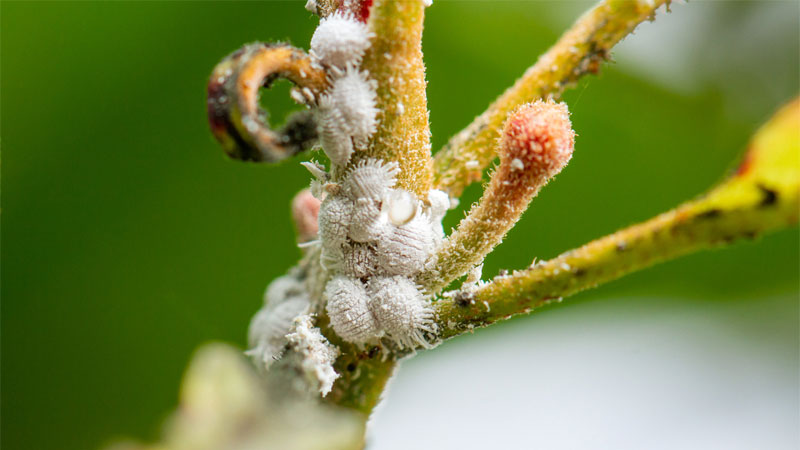
 Just tell me how to get rid of ’em.
Just tell me how to get rid of ’em.